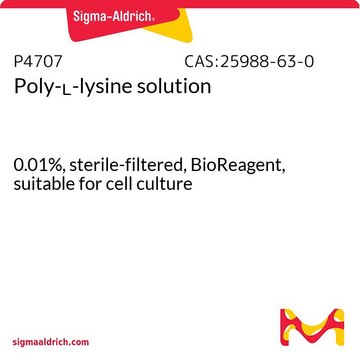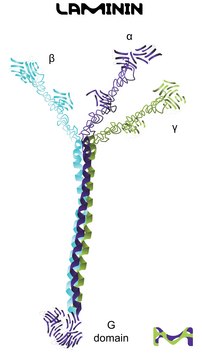추천 제품
Product Name
Poly-D-lysine hydrobromide, mol wt 70,000-150,000
양식
solid
Quality Level
분자량
70,000-150,000
기술
cell culture | mammalian: suitable
불순물
<10% water (Karl Fischer)
색상
white to off-white
solubility
water: 50 mg/mL, clear, colorless to very faintly yellow
작용기
amide
저장 온도
−20°C
SMILES string
O=C(C)[C@@](NC)([H])CCCCN.[Br]
InChI
1S/C6H14N2O2.BrH/c7-4-2-1-3-5(8)6(9)10;/h5H,1-4,7-8H2,(H,9,10);1H
InChI key
MEXAGTSTSPYCEP-UHFFFAOYSA-N
유사한 제품을 찾으십니까? 방문 제품 비교 안내
일반 설명
Poly-D-lysine hydrobromide (PDLHB) is a water-soluble, positively charged polyamino acid that has a variety of applications in biology and biomedicine. PDLHB is commonly used to promote cell adhesion to surfaces, which is essential for cell culture, microscopy, and neuroscience research. PDLHB is also used in tissue engineering and drug delivery research. Poly-D-lysine′s primary function lies in facilitating robust cell adhesion to surfaces, leveraging its positive charge to attract and anchor cells by binding with negatively charged proteins and molecules on cell surfaces. This feature is especially valuable when coating cell culture dishes and plates, where it proves essential for ensuring reliable cell adhesion, especially for challenging cell types like primary cells and specific cancer cells. In microscopy and neuroscience applications, PDLHB-coated substrates come to the forefront, allowing for the seamless attachment of cells, tissues, and neurons to slides and culture dishes. This fosters meticulous observation and exploration of these crucial biological components, making PDLHB an indispensable resource for in-depth investigations. Furthermore, PDLHB extends its utility to tissue engineering by supporting the creation of cell growth scaffolds. These PDLHB-coated scaffolds closely replicate the natural cellular environment, promoting effective healing and regeneration. In the realm of drug delivery, PDLHB plays a pivotal role, acting as a protective shield for encapsulated drugs and precisely guiding them to specific cells and tissues. This versatile and biocompatible polymer is an invaluable asset, elevating the standards of cell culture and biochemical research+R8 within the field of biology and biomedicine.
애플리케이션
Poly-D-lysine hydrobromide is used for the following applications:
- Used in animal cell culture
- Rat cortical neuron cultures
- Cell culture and siRNA treatment
- Primary cell cultures and adult neuronal network model
- Cortical astrocyte culture
- Immunofluorescence staining (HDF cells were plated onto poly-D lysine (P0899, Sigma-Aldrich) coated glass coverslips)
- NPC collection and culture conditions
Poly-D-lysine polymers can be used in preparing surfaces for cell attachment. The D-lysine polymers can also be used with cells that digest poly-L-lysine polymers and cause an excessive uptake of L-lysine.
This product is recommended as a cell culture substratum when using 0.5 - 1.0 mL of a 0.1 mg/mL solution to coat 25 cm2. Lower molecular weight versions of the product are less viscous, but high more molecular weight versions provide more attachment sites per molecule.
This product is recommended as a cell culture substratum when using 0.5 - 1.0 mL of a 0.1 mg/mL solution to coat 25 cm2. Lower molecular weight versions of the product are less viscous, but high more molecular weight versions provide more attachment sites per molecule.
생화학적/생리학적 작용
Poly-D-lysine (PDL) hydrobromide is a nonspecific attachment factor for cells useful in promoting cell adhesion to solid substrates by enhancing electrostatic interaction between negatively charged ions of the cell membrane and the culture surface. After absorption to the culture surface, poly-D-lysine increases the number of positively charged cell binding sites.
특징 및 장점
- Suitable for Cell Culture and Biochemical research
- High-quality compound suitable for multiple research applications
성분
Poly-D-lysine is a positively charged amino acid polymer with approximately one HBr per lysine residue. The hydrobromide allows the poly-D-lysine to be in a crystalline form soluble in water. A small amount of product may be found in the ß structure because the HBr interferes with hydrogen bonding between amino and either the carboxyl groups or N or O containing moieties.
주의사항
Sterile solutions are stable for up to 2 years when stored at 2-8°C. It should be stored desiccated at -20°C.
분석 메모
This product has a molecular weight of 70,000-150,000. To remove the HBr, dissolve this product in a neutral buffer and dialyze to remove the salts. In general, to use this product as an attachment factor, add 50 mL of sterile tissue culture grade water to 5 mg of poly-lysine, and aseptically coat the surface with 1 mL per 25 cm2 of solution. After 5 minutes, remove the solution through aspiration and thoroughly rinse the surface. Let dry for two hours before introducing cells and medium.
기타 정보
For additional information on our range of Biochemicals, please complete this form.
Storage Class Code
11 - Combustible Solids
WGK
WGK 3
Flash Point (°F)
Not applicable
Flash Point (°C)
Not applicable
개인 보호 장비
Eyeshields, Gloves, type N95 (US)
이미 열람한 고객
자사의 과학자팀은 생명 과학, 재료 과학, 화학 합성, 크로마토그래피, 분석 및 기타 많은 영역을 포함한 모든 과학 분야에 경험이 있습니다..
고객지원팀으로 연락바랍니다.






